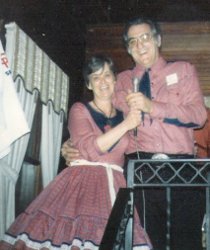
- DARK (no dancing) on Thanksgiving Eve (Nov. 26) and Christmas Eve (Dec. 24)
- Join us New Year's Eve (Dec. 31) for dancing and celebrate on New York time!
Information for Class Members
What Should I Wear?
Shoes
The most important item is your choice of shoe. You'll be on your feet for most of the class period, so wear comfortable shoes. Also, choose a shoe with a smooth sole, because square dancing is done with a shuffle-step — you'll be barely lifting your feet off the floor, so a sole that will slide smoothly over the wooden floor is a must. Athletic shoes or shoes with non-slip soles don't work well because they will tend to grip the floor rather than sliding.
Also, out of respect for the owners of our building, please avoid
soles made of materials that will leave marks on the floor.
Clothing
As far as clothing goes, you should wear neat, presentable, comfortable
clothing. It doesn't have to be fancy — save your best for
special Saturday-night dances. Pick something tasteful and
comfortable for the season (you'll want lighter-weight materials in
warm weather) which will allow you to move freely. Keep in mind
that tight-fitting clothing may become uncomfortable after a few "tips" of
dancing.
So-called "Traditional Square Dance Attire" is not required for Singles and Pairs classes and workshops. It can be worn if desired, but normal, neat and presentable street clothing is perfectly fine. Men are encouraged to wear long-sleeved shirts for traditional reasons (it used to be said that ladies objected to grasping a man's sweaty, hairy forearm), but this is not a requirement.

What is Traditional Square Dance Attire?
"Traditional" attire has only been around since the 1950s, when it grew out of what was then common to wear to parties or special occasions. In general, men wear slacks and a long-sleeved western-style shirt, with a scarf or bolo or clip-on tie. Ladies wear a full dress or blouse/skirt combination of approximately knee length with a rather full crinoline or crystal petticoat which pushes the skirt out to the sides and makes it easy to "swirl" the skirt while twirling or walking. The man's shirt and/or tie is often chosen to coordinate with the color of the lady's outfit.
In more recent years, the definition has been expanded to include
prairie-style skirts (without the large petticoat) for the ladies, in
addition to the original full skirts.
Rules of Etiquette
Taken, with minor
alterations, from the former website of retired Central California
caller Jim Penrod.
- Be on time (or, if possible, early)
In square dancing, one late person or couple can mean that three couples — or seven people — must sit out.
Also, in a class, the first couple of sets include review and practice on movements taught in the past few weeks, before new material is taught. Late arrivals will miss out on the warm-up and practice/review.
- Prepare thoughtfully to come to the dance
Be considerate of others' sensibilities. Use deodorant before coming to dance; if possible, bathe. Avoid foods such as onions and garlic, which will affect your breath unpleasantly, immediately prior to dancing; breath mints and/or chewing gum can sometimes help as well. Above all, don't drink alcohol prior to dancing, as it will affect both your coordination and your ability to learn.
- Get into squares quickly
- When the caller starts the music and announces "Square your
sets!," immediately join the square nearest to you that needs a couple.
- If you are looking for a square, raise your hand as you move
across the floor.
- If your square is not full, raise your hand with as many fingers extended as couples are needed.
- If two or three couples are
squared up and do not have a hand up, it indicates that they are
waiting for someone who has promised to dance with them; do not try to
square up with them without asking.
- Do not arrange squares more than once in an evening. It is
best not arrange a square at all.
- Do not get on the floor and expect the caller to find you a partner.
- When the caller starts the music and announces "Square your
sets!," immediately join the square nearest to you that needs a couple.
- Be a good listener
Talking during the course of square dancing is distracting to you and especially others. It makes it difficult for others in the square to "catch" the instructions and hear the music. Remember there is room for only one teacher at a time. You can help others best by being in the correct place at the correct time. Pointing or a hand motion is always the better way to direct someone that is going in the wrong direction.
- Be a courteous dancer
- Always introduce yourself and your partner to others in the square if you don't know them.
- Thank them for dancing with you after the tip.
- Don't use extra twirls and kicks that interfere with others in your square.
- It is considered "bad manners" to pass a square needing dancers in order to fill another.
- Even more important, beware of the unpardonable sin: never leave a square once you have joined it until the tip is over. If you must leave in an emergency, try to fill your spot with a substitute. By all means, tell the others why you must leave.
- Be a cooperative dancer
It might be said that square dancing is an activity where everyone is responsible for everyone else's happiness. A square is not made up of eight individuals working independently, but rather together as a team. An individual person attempting to show off or be a star can break up this teamwork and cause the square to fail. The real pleasure in square dancing comes when each person does his share in making the square run smoothly.
- Don't overdo
Square dancing can be strenuous exercise — the Mayo Clinic once said that an evening's square dancing is about equivalent to a five-mile walk. While it's important for class members to get as much floor time as possible, if you are too tired to dance, sit out. It is usually best to remove yourself from the hall or to the rest room—not the coffee room—until the tip has started. Sometimes you can learn a great deal just by watching and listening.
Be considerate. If another dancer is watching and listening, don't insist upon talking. Square dancing is a social event but not a place to socialize during tips or rounds even if you are not dancing.
- Be a friendly dancer
"Friendship is square dancing's greatest reward." Take the opportunity to get acquainted with others in the square. Make it a point to dance with as many different dancers as possible each evening. It has often been said that "Square dancing is friendship set to music."
- Enjoy yourself
Have fun. Come to the dance expecting to have a good time and you'll have it. Come to the dance with the attitude that it is the caller's job or someone else's job to show you a good time and chances are you will have a poor evening.
When you applaud at the end of a tip, you are thanking the caller and the other dancers in your square, but you are applauding yourself also for a good job well done.